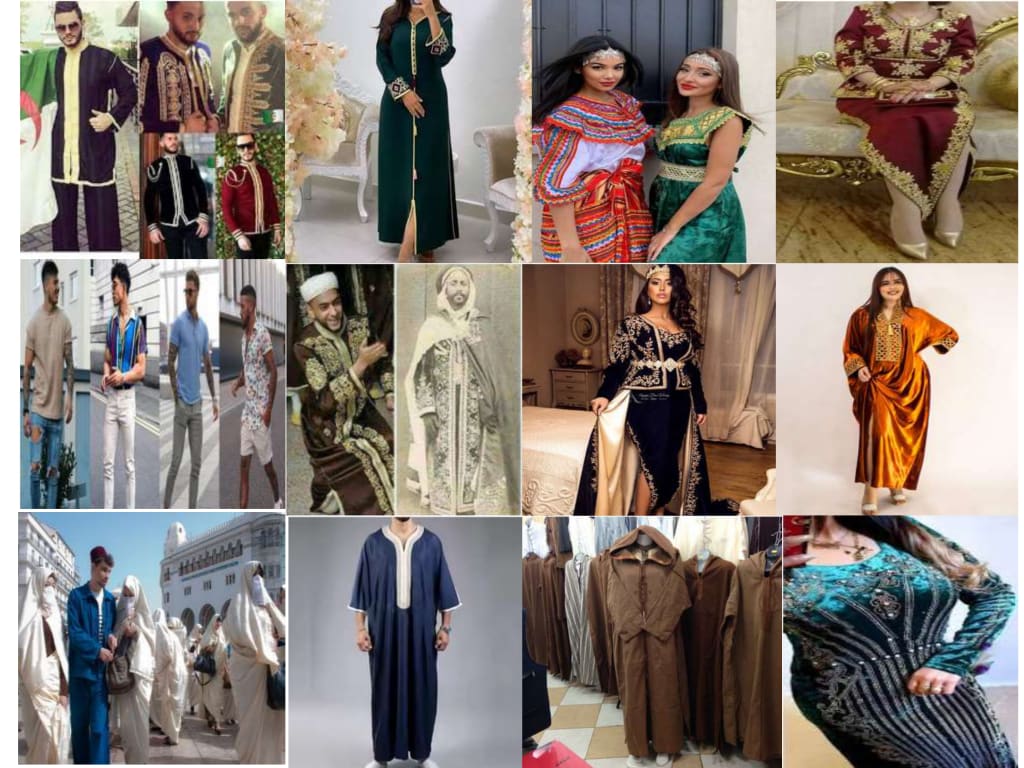
Every piece of wear made in Algeria is an encompassing of a culture, history, and geography in a unique holistic manner. From Atlas Mountains that stretch through northern part to vastnes of Sahara Desert that occupies the southern part, the disposition and individuals reflect the mosaic of the countries landscapes and identity. An excursion over time opens up to the evolution of Algerian attires, from old roots to new elements, recording a story of unconditional resistance, acceptance and pride through cultural identity.
North: An amalgamation of Northern Berber and Mediterranean traditions.
The storylines of the local clothing in northern regions of Algeria are based on the interaction of the Berber tradition and Mediterranean culture. The traditional Berber wardrobe has been famous for its bright colors, elaborate details, and resistant fabrics adjusted to the high mountainous landscape, and an extremely unstable climate.
The Berber women usually also wore handmade clothes such as the rectangular shawl "haik" or the dress of Kabyles that was beautiful with the embroidery and bright colors on it. As opposed to women who, generally speaking, opted for tight-fitted dresses such as the robe de style and the morocain dress, men tended to dress more loosely by wearing the gandoura, a long tunic, paired with the chechia, a conical hat.
The arrival of Arab and Ottoman influences caused a change in the Algerian clothing, a djellaba—a hooded robe for both men and women— and tarbouch, a hat which mostly covers men's head, are designs that were included. These attire, to a certain degree, were showcased the elements of external cultures but they were adapted everwise to match the peculiarities of local climate and lifestyle.
Nowadays, Algerian fashion in the north is defined by the fusion of traditiónal and modern styles. The urban centers such as Algiers and Oran serve as the space for fashion innovation, where designers work on the fusion of Berber patterns with global trends, which in turn result into the creation of fashion expressions that present the Algerian identity.
Central: Urbanization and inter-cultural process.
The western regions of the Algeria mainly include major cities like Algiers and Constantine whereas cultural and traditional melting pots. The emergence of urbanization and globalization has led to a mixture of clothing fashions, in which locals have as a result embraced different styles that are both within and without their borders.
Subsequently, in big cities, where modern style of dressing is fashionable among the youth, elderly still depend on their traditional dress code during cultural events and celebrations. The type of haik or the haik itself is a choice for woman, whilst man may choose between suit or the more casual gandoura.
As the "the City of Bridges", Constantine has a particular sartorial tradition that is based on its multicultural past. Alongside the traditional Algerian fashion, this place often hosts Mediterranean and Andalusian influences if you want to explore the city’s role as a crossroad of cultures.
South: Nomadic Customs and Deserts Adjustment
In Algeria's southern regions, the narrative of clothing generates to vocalize the severe combinations of the desert existence. Nomadic tribes including Tuareg and Chaamba continue to develop old garments, tailor them for a life in the ruthless Sahara.
Congratulated as "blue people" due to indigo colored clothes, the Tuareg women devote their lives to wearing Tagelmust or Litham, which mainly serve as protection against sun and sand. Ladies display their financial standing and position in society through their dress that is made of fine silver designed exquisitely.
However, the Chaamba are united by their skill in leatherwork and the popularity of embroidery among them. Their clothes, fully loaded with geometrical forms and dazzling colors, be as an art and also practical accessory of desert habitat.
Therefore it goes without saying that in spite of the struggle of the modernization and globalization, the traditional clothing represents the very core of the cultural heritage of southern Algeria. Nomadic life is gradually fading out and settled living is being adopted, but desert clothes denote robustness, tradition, and a tie to the land.
Saving Heritage in a Globalized Era
In a globalized world where tradition and heritage face challenges, the conservation of traditional clothes symbolizes the tenacity of the Algerian people and the domination of cultural identity. From the mountainous north to the vastness of the Sahara, Algerian clothing keeps evolving combining patterns of tradition, novelty, and pride. While the country is moving with the future, its clothing remains as a concrete bond with its celebrated history—a groove through time, from north to south.






Comments
There are no comments for this story
Be the first to respond and start the conversation.